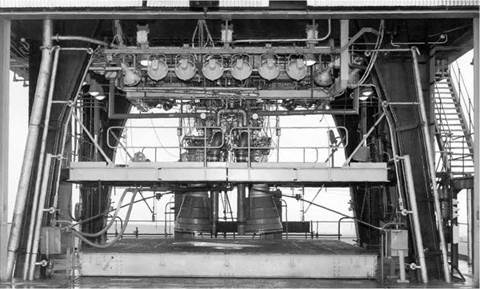Rocket Fuels
Liquid fuel rockets need a fuel and an oxidant. The UK used kerosene as a fuel almost exclusively, although a lot of work was done on liquid hydrogen, but sadly no use was made of this work. HTP (High Test Peroxide) was the most common oxidant: this was an 85% solution of hydrogen peroxide (H2O2) in water. The hydrogen peroxide decomposes to steam and oxygen on a catalyst (silver mesh gauze) and kerosene injected into the resultant hot gases ignited spontaneously. However, Blue Streak used engines (see Figure 1 below) licensed from the US and re-engineered, which burned oxygen and kerosene. The measure of the effectiveness of a rocket motor or fuel combination is called Specific Impulse. This was always written in documents of the period as S. I., but nowadays is usually written as Isp. This can be defined in many different ways: one is thrust times burn time divided by mass of fuel burnt. Another way of looking at it is the thrust obtained from each pound of fuel burned per second. The HTP/kerosene combination had a relatively low S. I., around 210-220 at sea level. Oxygen/kerosene gives an S. I. of around 245 at sea level. The effectiveness of a rocket motor is increased at high altitude or in vacuum. This is because the thrust from a rocket engine derives from the pressure difference between the pressure inside the combustion chamber and the pressure outside. In a vacuum there is no outside pressure. Thus S. I. is sometimes quoted at sea level and sometimes in vacuum. Vacuum S. I. is typically 10-15% higher than sea level. Hydrogen/oxygen is the most effective combination of all, reaching S. I.s of at least 400. This means double the thrust for the same weight of fuel (and burn time). Against that, there are weight penalties in the use of liquid hydrogen, since it has a very low density and needs large tanks. It is also very cold, boiling at -253 °C or 20 K, so the tanks usually need extra insulation, which in turn implies a further weight penalty.
|
Figure 1. Rolls Royce RZ 2 rocket motors in a test stand at Spadeadam. |











